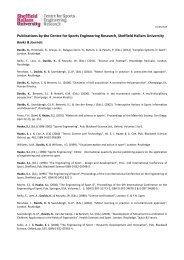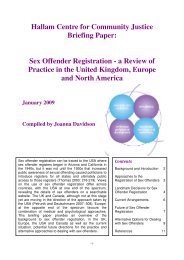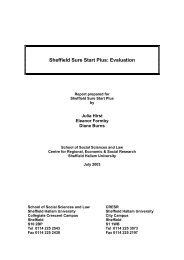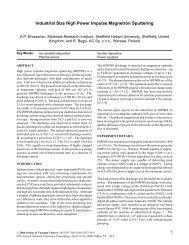The exercise of judicial discretion in rent arrears cases - Sheffield ...
The exercise of judicial discretion in rent arrears cases - Sheffield ...
The exercise of judicial discretion in rent arrears cases - Sheffield ...
Create successful ePaper yourself
Turn your PDF publications into a flip-book with our unique Google optimized e-Paper software.
shows that the vast majority <strong>of</strong> those <strong>cases</strong> where hous<strong>in</strong>g benefit was raised as an issue,<br />
across all the courts, resulted <strong>in</strong> an adjournment.<br />
An analytical approach<br />
Thus, a wide and diverse range <strong>of</strong> factors was reported by judges as be<strong>in</strong>g <strong>in</strong>fluential <strong>in</strong> how<br />
they <strong>exercise</strong>d their <strong>discretion</strong> <strong>in</strong> <strong>in</strong>dividual <strong>cases</strong>. <strong>The</strong>re was no evidence <strong>of</strong> judges hav<strong>in</strong>g<br />
regard to <strong>in</strong>appropriate factors, simply that they approached the task <strong>in</strong> the diffe<strong>rent</strong> ways set<br />
out above. What we have sought to do <strong>in</strong> this f<strong>in</strong>al section is to seek to understand and<br />
conceptualise the network <strong>of</strong> <strong>in</strong>fluences that <strong>in</strong>form how judges use their <strong>discretion</strong> <strong>in</strong><br />
hous<strong>in</strong>g possession <strong>cases</strong>. In do<strong>in</strong>g this, Lawrence’s work (1995) on sentenc<strong>in</strong>g processes<br />
provides a useful start<strong>in</strong>g po<strong>in</strong>t.<br />
By analys<strong>in</strong>g the forces <strong>in</strong>fluenc<strong>in</strong>g the use <strong>of</strong> <strong>discretion</strong> <strong>in</strong> <strong>judicial</strong> sentenc<strong>in</strong>g she develops<br />
a methodology which recognises sentenc<strong>in</strong>g as a complex cognitive process that is located<br />
with<strong>in</strong> a system <strong>of</strong> <strong>in</strong>teract<strong>in</strong>g micro and macro factors and <strong>in</strong>fluences. <strong>The</strong> macro forces are<br />
summarised as social/cultural attitudes and values, legislative and legal factors and<br />
<strong>in</strong>stitutional and bureaucratic arrangements.<br />
When deal<strong>in</strong>g with specific <strong>of</strong>fences and <strong>of</strong>fenders however, these broad structural<br />
<strong>in</strong>fluences are mediated through <strong>in</strong>dividual judges’ <strong>in</strong>terpretation and understand<strong>in</strong>g. Rather<br />
than seek<strong>in</strong>g a s<strong>in</strong>gle dom<strong>in</strong>ant causal explanation <strong>of</strong> sentenc<strong>in</strong>g outcomes, decisions,<br />
Lawrence concludes that these are located with<strong>in</strong> <strong>in</strong>dividual contextualised, <strong>in</strong>teractive and<br />
<strong>in</strong>terpretative processes. She claims that <strong>in</strong>dividual judges:<br />
“construct mean<strong>in</strong>gs for <strong>cases</strong>, apply their own objectives and beliefs, and respond to<br />
contextual factors with vary<strong>in</strong>g biases and vary<strong>in</strong>g levels <strong>of</strong> self awareness“<br />
(Lawrence 1995, p 70).<br />
Lawrence’s theoretical model <strong>of</strong> the way <strong>in</strong> which decision-mak<strong>in</strong>g is <strong>in</strong>formed by both<br />
structural and <strong>in</strong>dividual variables provides a useful start<strong>in</strong>g po<strong>in</strong>t to explore the complexity<br />
<strong>of</strong> factors which impact on the use <strong>of</strong> <strong>discretion</strong> <strong>in</strong> hous<strong>in</strong>g possession <strong>cases</strong>.<br />
Macro factors<br />
Social/Cultural Attitudes and Values<br />
<strong>The</strong> impact <strong>of</strong> macro social and cultural attitudes and values is not uniform but it is clear from<br />
<strong>in</strong>terviews with judges that the local context and wider culture exert some <strong>in</strong>fluence on the<br />
use <strong>of</strong> <strong>discretion</strong>. Reference to normative values and <strong>judicial</strong> consensus were not<br />
uncommon as the follow<strong>in</strong>g comment about Scenario 8 illustrates:<br />
104
















